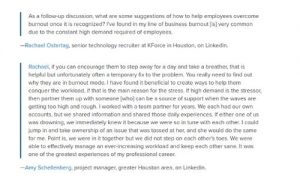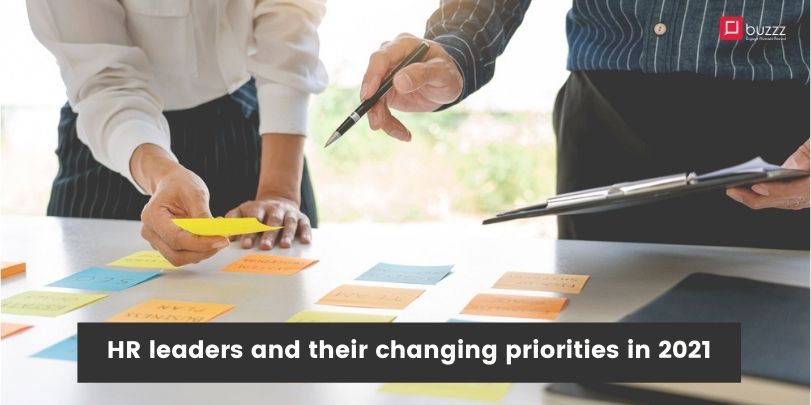HR leaders and their changing priorities in 2021
At the end of 2020, it was more important than ever for HR departments to take note of successes and failures, but this year it’s all about scrutinizing the strategy every 30 days or every quarter to stay on track.
It’s no surprise that organizational design and change management are the top priorities for HR managers in 2021. This priority is because 46% of HR executives feel that they are unable to lead change when it is necessary.
To prepare for the future, human resource leaders must develop and incorporate the following skillsets into their portfolio, according to Gartner.
- Technological competence- As CHROs are a crucial part of strategic business decision-making in 2021, they need to be well aware of the latest technologies to suggest or quickly adapt to the changes.
- Employee experience- The year 2021 is more than just basic employee engagement. It is about capturing employee needs and providing them with a richer experience.
When investing in your HR initiative, you should consider the trends that will significantly influence the way you design and implement strategies, processes, and best practices. The question for HR managers is: Do the trends look similar to what we have seen in the past? What immediate action and long-term adjustments will be necessary?
Here are the 6 key trends in human resources that should be included in your HR agenda for 2021 and beyond.
-
Return to work policy
Human resources experts and managers navigate the new normal by presenting a “return to work plan” that includes what employees can expect in their physical workplace and what others can expect. For both employees and employers, you should outline the safety measures to implement and comply with these new guidelines.
Getting back to work means examining all risk factors and determining when ‘return to work’ is most beneficial for your employees and your organization. A good return and work policy helps your business thrive while protecting and supporting employees.
Bennett Coleman & Co. Ltd adopted and leveraged the new-age collaboration tools and chose to transition to a hybrid work environment. With a continuous focus on Employee Safety & Business Continuity, BCCL’s hybrid working entails an effective mix of 60-20-20, 20% from home exclusively, 20% working from the office, while the rest 60% follow a revolving roster approach.
-
Revamp your performance management strategy
Rather than spending your time figuring out what your teams did well during the pandemic. Weed out the process that ain’t working and introduce new ones.
Analysis of prevailing performance management practices and leading trends in the industry can also help to develop a clear vision of what an effective performance management system should include.This review will help you understand how effective your current performance management system is and where it needs to be improved. In addition, evaluate the impact of changes and consider what could be further improved or optimized in your performance management process, and be ready to make changes if needed. Make sure that your process is driven clear stating the objective of your performance management system and that you make progress in achieving these objectives whilst managing your organization’s performance.
PwC handles its performance management by way of frequent and informal feedback. Regular feedback compared to annual reviews helps individuals to quickly cover the gap, maximize their strength and drive L&D throughout the year.
-
Build out an HR crisis plan
If your company is one of the 51 percent of organizations that admit they do not have a crisis management plan, now is the time to sit down and start planning. The creation of a crisis management plan (CMP) prepares your employees for everything that is coming their way.
If there is anything other than an immediate threat to your business, plan for the unexpected by creating a rapid response plan. The crisis management team rehearses the crisis plan by developing simulated scenarios for exercises and organizing the response as soon as it becomes clear that a crisis is underway.
SAP India has approached their Crisis Management Team to review their employee’s office entry and exit requests to access the office space by following all local COVID-19 regulations like social distancing, wearing masks and adhere to personal hygiene they are all set to allow their employees to office who wish to come and work from the office and for the remaining, they have allowed work from anywhere until June 30, 2021.
-
Protect your people from burnout
Burnout is a growing workplace epidemic affecting all employees, but many companies may not be doing enough to minimize burnout. Nearly 70 percent of professionals believe that employers in their companies do not do a good job of preventing or alleviating burnouts. But the truth is that proper management practices, such as nurturing managers and educating employees about the importance of passion, can help keep employees from burning out. Passion may not prevent stress in the workplace: 87 percent of professionals surveyed said they have passion in their current workplace, but 64 percent said they are stressed, dispelling the myth that passionate employees are immune to the stress of burnout, according to anF American Psychological Association survey.
Encouraging employees to manage their emotions differently, rather than suppressing them, will help reduce burnout. Because burnouts and signs of redundancy are so closely linked, strategies to reduce burnouts can have the effect of increasing involvement. If you try to prevent burnout among your employees, you can help people get back to a better state of mind by helping to make it feel as if it already feels different.
Finally, it should be borne in mind that work – at – play can increase the risk of burnout among employees. High employee engagement is a big goal, but it can come at a high price if not managed carefully.

Above is an example of how HR community is finding ways to tackle employee burnout in this pandemic. Source: Linkedin
-
Focus on total rewards
A carefully designed Total Rewards program helps to increase employee retention and attracts new candidates to the company. As for overall compensation trends, we see that many employers are adjusting a total compensation program to match their talent value promise. A well-planned overall reward strategy gains a decisive advantage in terms of attractiveness, engagement, and talent retention.
Listening carefully to what your employees say helps you determine exactly where your organization needs to focus on in your Total Rewards strategy. You will find that there are several areas that Total Rewards should cover, and how to develop and implement them within your organization, including employee engagement, employee retention, employee satisfaction and overall reward program satisfaction. This includes a variety of aspects from remuneration, to fixed remuneration to allowances and other benefits such as holiday and sick pay.
Willis Towers Watson has explained how 2020 has reinforced the importance of a renewed commitment to diversity and inclusion and the focus filtering down to all different aspects of total rewards in their article – The future of Total Rewards.
-
Employee health and wellbeing programs
When it comes to workplace wellness programs, there are many offerings that focus on different ways to help employees become and stay active, healthy and happy. At its core, a wellness program for companies is an employer’s main project – a plan designed to improve the physical and mental health of employees.
Staff wellness programs can be one-off events or they can be an ongoing schedule of activities. Employers can use a variety of health and wellness programs, such as physical activity, fitness, exercise, yoga, meditation and yoga classes. Health information collected through a well-designed wellness program can also be used in an aggregated form to develop effective disease-fighting programs and treatments. This is a great way to expand your traditional employee wellbeing program and reach out to the population that is at higher risk of living with chronic diseases and is one of the most effective ways to manage employee health risks. The health information collected during a wellness program can not only be used to give employees meaningful feedback and advice on their health risk status but can also be used as a basis for developing an effective program to treat diseases.
Synechron‘s Managing Director and Country Head India, Hareesha Pattaje expressed their top priority for the year 2021 which is employee physical and mental wellbeing. To ensure their employee’s safety needs they are offering the best support to their employees where they already have hospital tie-ups, insurance and virtual counseling sessions across locations.
Undoubtedly, RPA, AI and VR are not the only top trends that will dominate in 2021, but the above mentioned points will remain among the top priorities in the years to come. The biggest shift that we will see in 2021 is the continued decline of one-size-fits-all HR solutions. Existing solutions will require newer versions to give organizations more control over their data.
The biggest challenge for the HR department in 2021 will be to devise a way to truly transform the digital business. Working on a smart HR tech stack is the safest way to prepare your team for the future, prioritize your efforts, and achieve your human resources goals for 2021.
HR managers will have to overcome challenges and re-set priorities for 2021 in the coming months. Team Buzzz has helped brands and their CHROs find a solution to their workplace problem that has shown remarkable results in just a few months. If you too have any questions about the priorities for employee engagement and employee recognition for HR managers in the coming years, please contact us!

